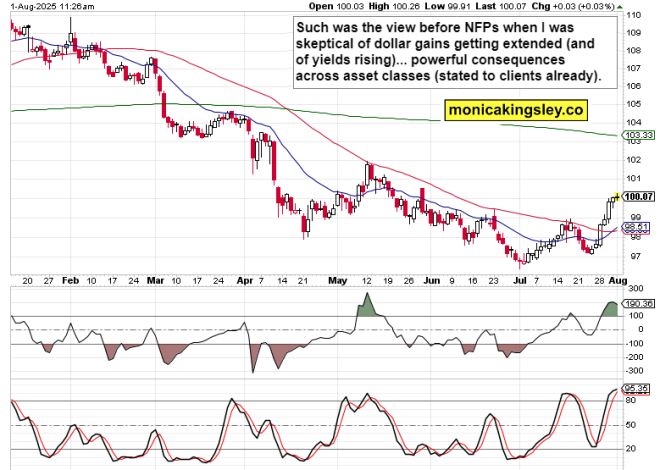
What to Do In regards to the Vanguard Automated Value Foundation Electronic mail
 By Dr. Jim Dahle, WCI Founder
By Dr. Jim Dahle, WCI FounderI have been getting emails from WCIers (and my very own daughter) that Vanguard is sending them emails with this message. The e-mail begins with the title: “Motion wanted: Select an automatic value foundation technique.”
And from there, Vanguard describes its latest resolution to cease utilizing the SpecID possibility as an automatic value foundation technique in your taxable account. As a substitute, starting in August 2025, it says the one automated strategies will embody: FIFO, MinTax, and HIFO.
This is your entire e mail.
The emailers ask, “Which one ought to I decide?”
Up to now, I’ve simply been reassuring them that it does not matter. As Vanguard says, “You will nonetheless be capable to use SpecID for particular person transactions.” I intend to take Vanguard up on that provide, as I at all times have when promoting shares to tax-loss harvest or donating shares to our Donor Suggested Fund (DAF). However since it’s important to decide one thing and since FIFO might be the worst factor to select, I inform them to select “MinTax,” which ought to be barely higher than HIFO.
I wasn’t positive why I had not but acquired this e mail. Maybe it was as a result of we’ve a fairly large account, so perhaps we’re exempt from the requirement. Maybe it is as a result of our taxable account is in a belief, and perhaps it is exempt. Perhaps Vanguard simply hasn’t gotten round to sending me an e mail, or I simply missed it by some means. I logged into my Vanguard account on July 23, 2025, to verify issues out. There have been no messages to me or any pop-up notices. So, I went to the price/foundation web page, and that is what I noticed.
Positive sufficient, my value foundation settings are nonetheless all on Particular Identification (SpecID) (properly, apart from DISV, a comparatively latest buy since it’s our tax-loss harvesting accomplice for AVDV).
I figured whereas I used to be in there, I’d simply change my technique. Positive sufficient, SpecID was nonetheless obtainable, and that is what I selected.
Whereas I don’t know why some Vanguard buyers are getting this message and I am not, it is a good alternative to debate the assorted value foundation strategies and what they imply. However first, let’s outline some phrases.
What Is Value Foundation?
Value foundation is solely what you paid for a safety, like a mutual fund. For those who purchased it for $10 a share and later promote it for $12 a share, your value foundation is $10. You will solely owe capital good points taxes on $2 per share. Consider it as your principal.
Extra info right here:
What Is a Tax Lot?
A tax lot is solely a single buy of shares purchased in a non-qualified (taxable) brokerage account at a selected time. For those who purchase shares each month, you will have a tax lot for each month. For those who log into your brokerage account and take a look at your value foundation (at Vanguard, click on on “Holdings,” use the menu to scroll all the way down to “Value basis-Unrealized good points/losses” after which scroll all the way down to the relevant account), it will look one thing like this:
On this instance, you possibly can see some bigger tax tons, just like the one on Oct. 9, 2018, and you’ll see periodic smaller ones, such because the one on December 21, 2018. That is what occurs in the event you’re reinvesting dividends in a taxable account. You simply find yourself with a complete bunch extra tax tons. It is not the tip of the world for the reason that brokerage will preserve monitor of all of them, but it surely does add some complexity. That is one cause why we do not reinvest dividends in our personal taxable account (the account above is a UTMA for one in all my children). The opposite cause is to lower wash sale points when tax-loss harvesting. So, we’ve rather a lot fewer tax tons for our holdings than our youngsters do, regardless of having a a lot bigger account. In truth, we solely have 4 tax a lot of VXUS (and 6 of IXUS, its tax-loss harvesting accomplice), one thing we have been investing in usually for a few years. By avoiding the automated reinvestment of dividends, consolidating tax tons when tax-loss harvesting, and donating shares to charity, you possibly can really preserve the variety of tax tons fairly low, even with giant accounts.
What Is a Value Foundation Technique?
The price foundation technique is solely how the brokerage, equivalent to Vanguard, decides which shares to promote while you go to promote shares. For instance, in case you have chosen First In, First Out; you do not manually choose which tax lot to promote; and also you go to promote 100 shares, the brokerage will merely promote the oldest 100 shares of that safety within the account. That will lead to less-than-ideal tax penalties, particularly in the event you’re making an attempt to tax-loss harvest the newest shares you bought.
What Are the Value Foundation Strategies?
Vanguard apparently at present affords (me) 4 of their 5 value foundation strategies from which to decide on. 4 of these 5 are fairly customary and obtainable wherever. Certainly one of them is comparatively new, and different brokerages have related new choices.
First In, First Out
First In, First Out (FIFO) is usually the default technique, though I am unsure why since plainly’s the worst attainable technique. Normally, the shares within the first tax lot you ever purchased had been most likely the most affordable. They’ve the bottom foundation and thus the best tax invoice related to their sale. However that is how FIFO works; the brokerage simply sells the primary shares to procure.
Final In, First Out
Final In, First Out (LIFO) appears a little bit bit higher. On this technique, the brokerage sells the newest shares bought till it will get to the variety of shares you could have ordered to promote. The idea on these ought to be rather a lot increased, and the tax invoice ought to be decrease. Nonetheless, there is a catch. These are usually not at all times the best foundation shares since share worth fluctuates. Plus, there’s rather a lot higher probability that the newest shares bought had been purchased throughout the final 12 months, and promoting these at a achieve would lead to a short-term capital achieve (taxed at odd revenue tax charges) as a substitute of a long-term capital achieve eligible for the decrease long-term capital good points tax charges.
Common Value
Common Value (AvgCost) could be straightforward, but it surely’s additionally a less-than-ideal technique for these of us who really need to reduce our tax burdens. It principally simply averages your value foundation for your entire shares ever bought. The worst half about this technique is that after you promote some shares for a holding utilizing AvgCost, you are locked into that technique till all of the shares are bought. Perhaps there’s a scenario the place it is a good factor, however I am unable to consider one. It might even flip long-term good points into short-term good points. This technique is so dangerous that Vanguard makes you choose into it in writing somewhat than on-line.
Particular Identification
Particular Identification (SpecID) solves all these points by letting you manually choose which tax tons to promote. It is positively the best way you need to cope with the gross sales of any shares in the event you care about controlling your tax invoice. This lets you tax-loss harvest solely shares with losses. It means that you can be sure that something bought with a achieve has a long-term capital achieve. It means that you can donate to charity the bottom foundation shares owned for not less than a 12 months. For those who’re within the 0% capital good points bracket and need to make the most of that, it means that you can choose the bottom foundation shares so you possibly can tax-gain harvest. When raiding my oldest daughter’s UTMA these days, I have been selecting the low foundation shares, as she does not have sufficient revenue to owe any long-term capital good points taxes on these gross sales. By the way, I not have entry to her UTMA since her twenty first birthday, so I am educating her cope with this challenge. Now, she will legally get drunk and improve her personal tax invoice.
Minimal Tax
The Minimal Tax (MinTax) technique is the latest addition to the checklist. Since SpecID works so properly, I did not hassle studying precisely the way it works till not too long ago. I feel it is for individuals who do not actually perceive value foundation and capital good points tax or who simply cannot be bothered with particulars like that. For this submit, I dove into the way it really works. Fortunately, Vanguard supplies a definition of every technique together with execs and cons. This is what it says about MinTax:
Particularly, Vanguard says it sells shares on this order:
- Quick-term capital loss from largest to smallest.
- Lengthy-term capital loss from largest to smallest.
- Quick-term zero achieve or loss.
- Lengthy-term zero achieve or loss.
- Lengthy-term capital achieve from smallest to largest.
- Quick-term capital achieve from the smallest to largest.
Mainly, it assumes you aren’t within the 0% LTCG bracket and sells the shares that can consequence within the lowest tax invoice for this transaction. More often than not, that is first going to be any shares with a loss, adopted by the best foundation shares with a achieve that you’ve owned for not less than a 12 months. That is a protracted checklist of cons above, although, so I will preserve utilizing SpecID and manually choose which shares are bought—even when, sooner or later, I can not select it as my “default” value foundation technique. SpecID permits me to consolidate tax tons by promoting/giving tiny tons and minimizing my general lifetime tax invoice. However as a default technique, sure, MinTax is fairly darn good.
Extra info right here:
Vanguard vs. Constancy — Which Is Finest for Your Investments?
Will I Be Protected If My Funding Dealer Goes Bankrupt?
Constancy
Different brokerages additionally supply value foundation strategies designed to scale back your tax burden. For those who go to Constancy, you will see much more choices, together with:
- First In, First Out
- Intraday First In, First Out
- Final In, First Out
- Excessive Value
- Excessive Value, Lengthy Time period
- Excessive Value, Quick Time period
- Low Value
- Low Value, Lengthy Time period
- Low Value, Quick Time period
- Tax Delicate
- Tax Delicate, Quick Time period
Take a look at all of the stuff you do not have to be taught in the event you’re prepared to simply particularly determine the tax tons from which you want to promote shares! Listed here are Constancy’s descriptions:
Schwab
Schwab does not supply as many choices as Constancy, but it surely nonetheless has the next
- First In, First Out
- Final In, First Out
- Common Value
- Low Value
- Excessive Value
- Tax Lot Optimizer
- Particular Identification
Tax Lot Optimizer appears to be about the identical as MinTax at Vanguard and Tax Delicate at Constancy. The Schwab description reads:
“The Tax Lot Optimizer makes use of an algorithm to calculate the optimum approach to reduce the tax impression of every sale. Normally, the purpose is to promote investments for losses first (short-term losses, then long-term losses) and good points final (long-term good points, then short-term good points). Just like the high-cost lot technique, the Tax Lot Optimizer seems to be for the best value shares first, and the algorithm additionally considers the holding interval of every share. This technique generally is a good possibility for buyers looking for to attenuate taxes or trying to tax-loss harvest. However bear in mind, though this technique tries to keep away from short-term capital good points, that is not at all times attainable if shares have been held lower than one 12 months.
In case you are unsure what you are most likely presupposed to do while you’re utilizing SpecID, that ought to provide you with a fairly good concept. Promote shares with excessive foundation owned for not less than a 12 months, and provides shares with low foundation owned for not less than a 12 months.
The Backside Line
When promoting or giving shares out of your taxable account, particularly determine these shares. If Vanguard is forcing you to decide on a “default value foundation technique,” select MinTax.
What do you suppose? Did you get the letter? What did you select? Do you do something aside from SpecID when promoting or giving shares?














